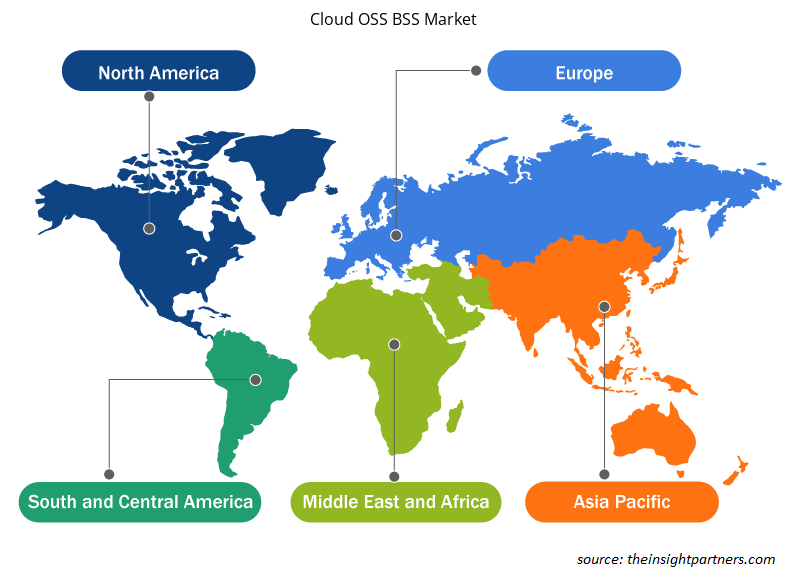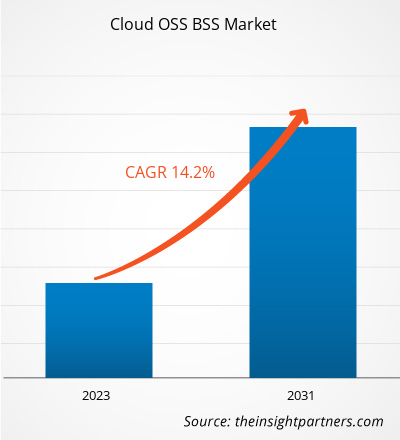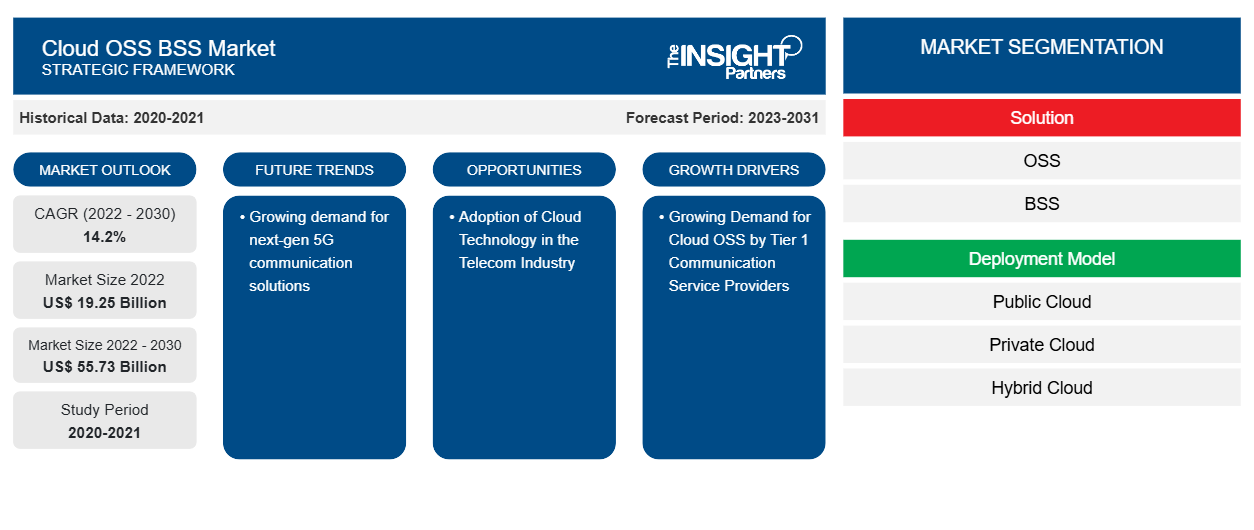Der Markt für Cloud-OSS-BSS soll von 19,25 Milliarden US-Dollar im Jahr 2022 auf 55,73 Milliarden US-Dollar im Jahr 2030 anwachsen. Der Markt wird zwischen 2022 und 2030 voraussichtlich eine durchschnittliche jährliche Wachstumsrate (CAGR) von 14,2 % verzeichnen. Die wachsende Nachfrage nach 5G-Kommunikationslösungen der nächsten Generation dürfte ein wichtiger Trend auf dem Markt bleiben.
Cloud OSS BSS Marktanalyse
Unternehmen, die Cloud-Betriebsunterstützungssysteme (OSS) und Business-Support-Systeme (BSS) entwickeln, investieren erheblich in die Entwicklung neuer und innovativer Lösungen, um der wachsenden Nachfrage nach diesen Produkten gerecht zu werden. Die Anbieter fügen ihren Lösungen verschiedene Funktionen hinzu, um sich von ihren Mitbewerbern abzuheben. Im Juli 2021 gab Sterlite Technologies Ltd (STL) seinen Plan bekannt, eine Partnerschaft mit Microsoft einzugehen, um Telekommunikationsdienstleistern Cloud-native OSS/BSS-Lösungen anzubieten. Diese Lösungen würden Telekommunikationsunternehmen dabei helfen, über ihre digitale BSS-Plattform zukunftssichere Anwendungen zu entwickeln. Im Rahmen dieser Partnerschaft wird STL Telekommunikationsunternehmen Zugang zu flexiblen modularen Mikrodiensten, einem Cloud-nativen und umfassenden Ökosystem für die App-Entwicklung und einem hybriden Cloud-Managementsystem bieten. Solche Innovationen bei Cloud-OSS-BSS-Lösungen, unterstützt durch hohe Investitionen der Anbieter zur Erweiterung ihrer Produktportfolios, um den sich ändernden Kundenanforderungen gerecht zu werden, treiben das Wachstum des Cloud-OSS-BSS-Marktes voran
Cloud OSS BSS Marktübersicht
Betriebsunterstützungssysteme und Geschäftsunterstützungssysteme nutzen Cloud Computing, Automatisierungstools und Analysen, um die Abläufe in der gesamten Telekommunikationsorganisation, einschließlich Betriebsabläufen und Kundenaktivitäten, zu optimieren . Durch die gemeinsame Nutzung von OSS und BSS können Telekommunikationsunternehmen ihre Kunden problemlos mit zuverlässigen Technologielösungen verbinden.
Passen Sie diesen Bericht Ihren Anforderungen an
Sie erhalten kostenlos individuelle Anpassungen an jedem Bericht, einschließlich Teilen dieses Berichts oder einer Analyse auf Länderebene, eines Excel-Datenpakets sowie tolle Angebote und Rabatte für Start-ups und Universitäten.
- Holen Sie sich die wichtigsten Markttrends aus diesem Bericht.Dieses KOSTENLOSE Beispiel umfasst eine Datenanalyse von Markttrends bis hin zu Schätzungen und Prognosen.
Treiber und Chancen für den Cloud-OSS-BSS-Markt
Wachsende Nachfrage nach Cloud-OSS durch Tier-1-Kommunikationsdienstleister
Cloud-OSS-Lösungen helfen der Kommunikationsbranche, viele geschäftliche und technische Herausforderungen zu bewältigen. Aufgrund seiner heterogenen Technologie- und Anbieterlandschaft wird Cloud-OSS für mehrere Anwendungen verwendet. Diese Lösungen bieten eine effiziente und einfache Möglichkeit zur gemeinsamen Nutzung, Automatisierung und Überwachung von Ressourcen. Mithilfe von Cloud-OSS-Lösungen vereinfachen CSPs Software-Upgrade-Verfahren und senken so die Kosten erheblich, indem sie nahezu keine Ausfallzeiten während des Upgrades gewährleisten. Cloud-OSS kommt Tier-1-CSPs zugute, indem es die Elastizität bietet, um Szenarien mit starkem Datenverkehr ohne Vorabinvestitionen zu bewältigen. Die Cloud-OSS-Lösung ermöglicht auch eine schnellere Markteinführung neuer Dienste, da neue Funktionen bei Bedarf problemlos nach oben oder unten skaliert werden können. Darüber hinaus bieten Cloud-OSS-Lösungen Tier-1-CSPs Big-Data-Lösungen und -Analysen. Der daraus resultierende Anstieg der Nachfrage nach Cloud-OSS-Lösungen bei diesen Dienstanbietern beflügelt den Cloud-OSS-BSS-Markt.OSS solutions help the communications industry address many business-related and technical challenges. Cloud OSS is used for multiple applications due to its heterogeneous technology and vendor landscape. These solutions offer an efficient and easy way for resource sharing, automation, and monitoring. Using cloud OSS solutions, CSPs simplify software upgrade procedures, thus reducing the cost considerably by ensuring near-zero downtime during the upgrade. Cloud OSS benefits Tier 1 CSPs by providing elasticity to handle burst traffic scenarios without any upfront investment. The cloud OSS solution also provides a faster time-to-market for new services as new capabilities can be easily scaled up or down on demand. Furthermore, cloud OSS solutions provide Tier 1 CSPs with big data solutions and analytics. Thus, the resultant rise in demand for cloud OSS solutions among these service providers boosts the cloud OSS BSS market.
Einführung der Cloud-Technologie in der Telekommunikationsbranche
Die Cloud-Technologie hat erhebliche Auswirkungen auf die Telekommunikationsbranche, da sie die Betriebs- und Verwaltungskosten der Telekommunikationsunternehmen senkt. Außerdem verbessert sie deren Kommunikation und Zusammenarbeit mit Content-Delivery-Netzwerken. Darüber hinaus helfen Cloud-Dienstanbieter den Telekommunikationsunternehmen, sich auf wesentliche Geschäftsdienste zu konzentrieren, anstatt sich mit IT, Server-Updates und Wartungsproblemen herumschlagen zu müssen. Die Cloud-Technologie hat die Zahl der Telekommunikationsanbieter weltweit erhöht. Plattformen für Cloud-Delivery-Modelle bieten IT- und Kommunikationsdienste über alle Netzwerke , z. B. Festnetz und Mobilfunk, mit weltweiter Abdeckung. Alle angeschlossenen Geräte der Endbenutzer, z. B. Smartphones, PCs und Fernseher, können ebenfalls verwendet werden. Die zunehmende Einführung der Cloud-Technologie in der Telekommunikationsbranche schafft also mehr Möglichkeiten für den Markt.telcos. It also enhances their communication and collaboration with content delivery networks. Additionally, cloud service providers help telecom firms focus on essential business services rather than IT, server updates, and maintenance issues. The cloud technology has increased the number of telecommunications providers worldwide. Cloud delivery model platforms provide IT and communication services across any
Cloud OSS BSS Marktbericht SegmentierungsanalyseOSS BSS Market Report Segmentation Analysis
Wichtige Segmente, die zur Ableitung der Cloud-OSS-BSS-Marktanalyse beigetragen haben, sind Lösung, Bereitstellungsmodell und Unternehmensgröße.
- Basierend auf der Lösung ist der Cloud-OSS-BSS-Markt in OSS (Netzwerkmanagement und -orchestrierung, Ressourcenmanagement, Analyse und Sicherung sowie Servicedesign und -erfüllung) und BSS (Abrechnungs- und Umsatzmanagement, Produktmanagement, Kundenmanagement und andere) unterteilt. Das OSS-Segment hatte im Jahr 2022 einen größeren Marktanteil.
- Nach Unternehmensgröße ist der Markt in kleine und mittlere Unternehmen sowie große Unternehmen und Branchen (IT und Telekommunikation, BFSI, Medien und Unterhaltung, Gesundheitswesen und andere) segmentiert.
Cloud OSS BSS Marktanteilsanalyse nach Geografie
Der geografische Umfang des Cloud-OSS-BSS-Marktberichts ist hauptsächlich in fünf Regionen unterteilt: Nordamerika, Asien-Pazifik, Europa, Naher Osten und Afrika sowie Süd- und Mittelamerika.
Nordamerika dominiert den Cloud-OSS-BSS-Markt. Die USA halten mehr als die Hälfte des regionalen Umsatzanteils, da sie den reifsten Telekommunikationsmarkt haben. Andererseits würde der zunehmende Wettbewerb zwischen Kommunikationsdienstleistern um die Vergrößerung des Kundenstamms und die Verbesserung der Betriebseffizienz Wachstumschancen für den Cloud-OSS-BSS-Markt in Kanada bieten.
Regionale Einblicke in den Cloud-OSS-BSS-Markt
Die regionalen Trends und Faktoren, die den Cloud-OSS-BSS-Markt im Prognosezeitraum beeinflussen, wurden von den Analysten von Insight Partners ausführlich erläutert. In diesem Abschnitt werden auch die Marktsegmente und die Geografie des Cloud-OSS-BSS-Marktes in Nordamerika, Europa, im asiatisch-pazifischen Raum, im Nahen Osten und Afrika sowie in Süd- und Mittelamerika erörtert.

- Holen Sie sich die regionalspezifischen Daten für den Cloud-OSS-BSS-Markt
Umfang des Cloud-OSS-BSS-Marktberichts
| Berichtsattribut | Details |
|---|---|
| Marktgröße im Jahr 2022 | 19,25 Milliarden US-Dollar |
| Marktgröße bis 2030 | 55,73 Milliarden US-Dollar |
| Globale CAGR (2022 - 2030) | 14,2 % |
| Historische Daten | 2020-2021 |
| Prognosezeitraum | 2023–2031 |
| Abgedeckte Segmente | Nach Lösung
|
| Abgedeckte Regionen und Länder | Nordamerika
|
| Marktführer und wichtige Unternehmensprofile |
|
Marktteilnehmerdichte: Der Einfluss auf die Geschäftsdynamik
Der Cloud-OSS-BSS-Markt wächst rasant, angetrieben durch die steigende Nachfrage der Endnutzer aufgrund von Faktoren wie sich entwickelnden Verbraucherpräferenzen, technologischen Fortschritten und einem größeren Bewusstsein für die Vorteile des Produkts. Mit steigender Nachfrage erweitern Unternehmen ihr Angebot, entwickeln Innovationen, um die Bedürfnisse der Verbraucher zu erfüllen, und nutzen neue Trends, was das Marktwachstum weiter ankurbelt.
Die Marktteilnehmerdichte bezieht sich auf die Verteilung der Firmen oder Unternehmen, die in einem bestimmten Markt oder einer bestimmten Branche tätig sind. Sie gibt an, wie viele Wettbewerber (Marktteilnehmer) in einem bestimmten Marktraum im Verhältnis zu seiner Größe oder seinem gesamten Marktwert präsent sind.
Die wichtigsten auf dem Cloud-OSS-BSS-Markt tätigen Unternehmen sind:
- Amdocs GmbH
- Oracle Corp
- Telefonaktiebolaget LM Ericsson
- Hewlett Packard Enterprise Development LP
- Huawei Technologies Co Ltd
- Axino Solutions GmbH
Haftungsausschluss : Die oben aufgeführten Unternehmen sind nicht in einer bestimmten Reihenfolge aufgeführt.

- Überblick über die wichtigsten Akteure auf dem Cloud-OSS-BSS-Markt
Cloud OSS BSS Marktnachrichten und aktuelle Entwicklungen
Der Cloud-OSS-BSS-Markt wird durch die Erfassung qualitativer und quantitativer Daten nach Primär- und Sekundärforschung bewertet, die wichtige Unternehmensveröffentlichungen, Verbandsdaten und Datenbanken umfasst. Nachfolgend sind einige der Entwicklungen auf dem Cloud-OSS-BSS-Markt aufgeführt:
- Vodafone hat eine neue strategische Partnerschaft mit Oracle bekannt gegeben. Die Partnerschaft wurde als Teil der laufenden Bemühungen von Vodafone formuliert, sich zu einem vollwertigen Technologieunternehmen zu entwickeln, das eine radikale Überholung und Modernisierung seiner IT-Systeme vorsieht. Die Idee besteht darin, Vodafone eine „dedizierte Cloud-Plattform“ bereitzustellen, um „Tausende von Oracle-Datenbanken“ zu modernisieren sowie seine „unternehmenskritischen“ OSS- und BSS-Systeme, einschließlich CRM und Auftragsmanagement, zu unterstützen und zu skalieren. Auf diese Weise kann Vodafone schneller neue Cloud-basierte Anwendungen erstellen und diese gleichzeitig in mehreren Märkten etablieren. (Quelle: Vodafone, Pressemitteilung, März 2022.)
- Um ihre digitale Transformation zu beschleunigen und neue Einnahmequellen aus ihrem wachsenden 5G-Netzwerk zu erschließen, führt die Emirates Integrated Telecommunications Company (EITCdu) laut einer Pressemitteilung von Hewlett Packard Enterprise die End-to-End-Service-Orchestrierungssoftware von HPE ein. du migriert von einem Altsystem zu einem Operations Support System (OSS) der nächsten Generation, um neue Dienste zu unterstützen und das Kundenerlebnis zu verbessern. Diese von HPE unterstützte digitale Transformation wird es du ermöglichen, sein Angebot zu erweitern, die Markteinführungszeit zu verbessern und seine 5G-Investition zu monetarisieren. (Quelle: Emirates Integrated Telecommunications Company, Pressemitteilung, Februar 2022)
Abdeckung und Ergebnisse des Cloud-OSS-BSS-Marktberichts
Der Bericht „Cloud OSS BSS-Marktgröße und -Prognose (2020–2030)“ bietet eine detaillierte Analyse des Marktes, die die folgenden Bereiche abdeckt:
- Cloud OSS BSS Marktgröße und Prognose auf globaler, regionaler und Länderebene für alle wichtigen Marktsegmente, die im Rahmen des Geltungsbereichs abgedeckt sind
- Cloud OSS BSS-Markttrends sowie Marktdynamik wie Treiber, Einschränkungen und wichtige Chancen
- Detaillierte PEST/Porters Five Forces- und SWOT-Analyse
- Cloud-OSS-BSS-Marktanalyse mit wichtigen Markttrends, globalen und regionalen Rahmenbedingungen, wichtigen Akteuren, Vorschriften und aktuellen Marktentwicklungen
- Branchenlandschaft und Wettbewerbsanalyse, die die Marktkonzentration, Heatmap-Analyse, prominente Akteure und aktuelle Entwicklungen für den Cloud-OSS-BSS-Markt umfasst
- Detaillierte Firmenprofile
- Historische Analyse (2 Jahre), Basisjahr, Prognose (7 Jahre) mit CAGR
- PEST- und SWOT-Analyse
- Marktgröße Wert/Volumen – Global, Regional, Land
- Branchen- und Wettbewerbslandschaft
- Excel-Datensatz
Aktuelle Berichte
Erfahrungsberichte
Grund zum Kauf
- Fundierte Entscheidungsfindung
- Marktdynamik verstehen
- Wettbewerbsanalyse
- Kundeneinblicke
- Marktprognosen
- Risikominimierung
- Strategische Planung
- Investitionsbegründung
- Identifizierung neuer Märkte
- Verbesserung von Marketingstrategien
- Steigerung der Betriebseffizienz
- Anpassung an regulatorische Trends





















 Kostenlose Probe anfordern für - Cloud-OSS-BSS-Markt
Kostenlose Probe anfordern für - Cloud-OSS-BSS-Markt